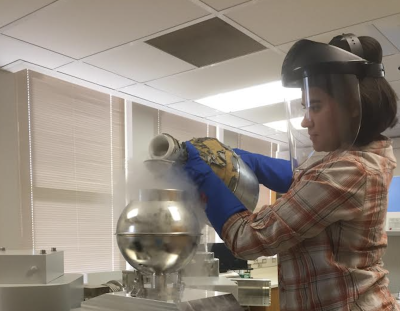Alumni Change Lives featuring Teresa Avila
Teresa Avila is a graduate student in SES advised by Matt Saltzman. Here, she shares how Friends of Orton Hall helped her further her studies.

The broad goal of my research is to understand how silicate weathering impacts global climate over geologic time scales. My master's and PhD projects both address this question in the context of the Ordovician and Devonian periods, respectively. In both time periods, the strontium isotope ratio (87Sr/86Sr) serves as a proxy for silicate weathering patterns while oxygen isotope values are used to track average global sea surface temperature. In comparing these curves, one can draw conclusions on how silicate weathering could have impacted or been impacted by global temperatures. In the Ordovician period, as part of my master's thesis, I concluded that an inflection point in 87Sr/86Sr occurred in the holodentata conodont biostratigraphic zone, and that this correlated with a global transgression in the form of the Sauk-Tippecanoe sequence boundary. This suggests that an increased rate of seafloor spreading could have occurred at this time, potentially causing an increased rate of volcanism and a slowing of the cooling trend observed over the course of the Ordovician.
Funds from Friends of Orton Hall has helped me travel to GSA Phoenix in September 2019 to present my master's research in an Ordovician-focused session that I also helped organize and chair. In addition, I was able to help run OSU’s recruitment booth, which was important in finding the next generation of SES graduate students. As part of my PhD project, I will collect 87Sr/86Sr from conodont microfossil samples from various locations in order to construct a better constrained 87Sr/86Sr curve for the Devonian. Using this curve, I will draw conclusions on how the 87Sr/86Sr and oxygen isotope curves correlate, and how silicate weathering could have impacted global climate or vice versa. In order to eliminate uncertainty of time and correlation of the two curves, I will use the same conodont microfossil samples used in a 2009 oxygen isotope study of the Devonian by Joachimski et al. Funds from FOH have aided my PhD work by helping me travel to Dr. Joachimski’s lab in Erlangen, Germany to collect the samples he used for his oxygen isotope study. In addition, I traveled to Bologna and Trieste in Italy to meet with two conodont workers, Dr. Spalletta and Dr. Corradini, who provided perspective on Devonian-age conodonts as well as additional conodont samples to analyze for 87Sr/86Sr.
The School of Earth Sciences relies on the generous support of our alumni and friends to provide programs, scholarships and facilities that enrich the experience of our students, provide life-changing opportunities, and enable world-changing discoveries. The Friends of Orton Hall gifts are distributed to students in support of degree research work. If you are interested in giving to support the Friends of Orton Hall or other funds, please visit our giving page.
